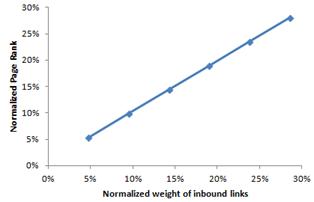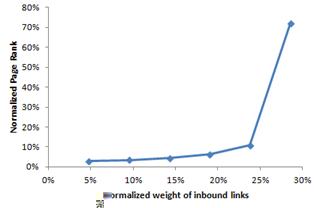Page Rank Experiment
In this section, I will show some transformation and raise some questions to encourage you to do some experiments using the tool of Page Rank algorithm.
Drawing the normalized weight of the outbound links versus the normalized page rank make it clear that page rank algorithm transforms the weight from linear into non-linear scale with putting more importance to a page that has more inbound links. The more links from outside to your web page, the higher your page rank.
|
|
|
|
As summary, I have shown the simple computation of the original Google Page Rank using spreadsheet without any macro.
|
Web Page name |
Number of self link |
Number of outbound links (external links) |
Number of inbound links |
Total number of links |
Page Rank |
|
A |
1 |
5 |
0 |
6 |
4.325440287 |
|
B |
1 |
4 |
1 |
6 |
0.648816037 |
|
C |
1 |
3 |
2 |
6 |
0.373069221 |
|
D |
1 |
2 |
3 |
6 |
0.267366275 |
|
E |
1 |
1 |
4 |
6 |
0.210550942 |
|
F |
1 |
0 |
5 |
6 |
0.174757282 |
With this tool, you can now explore on your own to do experiments to answer the following questions
- What happens to a web page that does not have any link?
- What is the effect of parameter d?
- What is the effect of inbound links?
- What is the effect of outbound links?
- What happens to a page that has many inbound link but has no outbound link?
- What is the effect of self links?
- What happen to the page rank if a page has too many self links?
- What is the effect of the ratio of inbound links to outbound links?
- What is the effect of the number of pages?
- The real page rank has maximum value of 9, how can you normalize to the maximum value?
Spreadsheet companion of this tutorial can be downloaded here .
Rate this tutorial or give your comments about this tutorial



